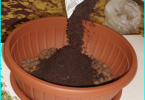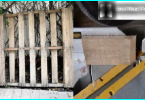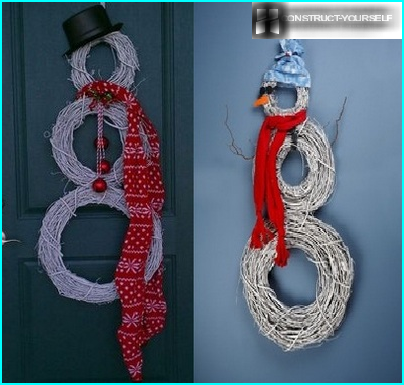
A few centuries ago, our ancestors from sharp wooden stakes have created a safe and beautiful fencing – palisade fence. Today it is a functional protective design is once again becoming popular in residential construction. Palisade is the perfect addition to the plot elements «ethno» decor or decorated in «rustic style». In addition to the decorative appeal of the fence of logs serves as a great protection from the encroachment of unwanted guests. To break such a fence beyond the power of even the strongest, has nedyuzhy ability. Palisade is a great alternative to traditional concrete, brick or metal protective structures. To build a stockade just a few days, and last a wooden fence for decades.
The contents
We procure materials for construction
The palisade is assembled from a cylindrical wooden logs with the same diameter of the barrel. Because today the owners of suburban areas there is no need to defend the powerful fence against enemy attacks, for the arrangement of the fence enough to use logs with a diameter of 10-15 cm.
The height of the logs is determined based on the purpose of the building envelope. For the outer fence that protects against the penetration of thieves, will need logs with a height of not less than 2 meters. The arrangement of internal walls, dividing the zone area and enclosing domestic livestock, suitable small logs two feet in height.
To logs not swayed in the wind and was securely fastened, they must be sunk. The variant of the fastening of the logs raised above the ground cross beam which is fixed on the load-bearing pillars of the building envelope. In this case, the logs will not bury and full height will be placed over the earth.
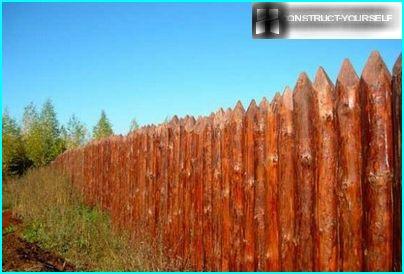
To determine the height of the product, note that in the traditional method of arranging 1/3 of the height of the barrel will be spent on strengthening structures
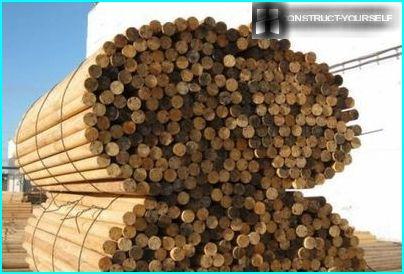
Choosing the material for the fence, it is necessary to focus primarily on the quality of logs
The economy is not relevant: the quality of the products depends on the lifetime of the whole structure. And therefore it is better to spend more but get a fence that will certainly last a couple of decades, than to save up and buy a fence only 2-3 years. The surface of the logs in the cross section must not have any recesses and protrusions. A distinctive feature of the palisade – pointed top.
Honed the beam looks like a large pointy pencil. Focus the log at an angle of 35-40° with the normal small hatchet.
Processing and protection of logs
The traditional way of arrangement of the palisade part of the log will be buried in the ground, it could lead to wood rot. Unprotected wood in 2-3 years will become worthless and collapse, and a protective structure will have to change to something new. To extend the life of the stockade, our ancestors processed the lower part of the stake by charring in the fire. The result was a charred 15 cm crust, which prevented the destruction of wood. The charring was to be not only buried in the ground part of the log, but the section of the trunk 20-25 cm above the ground. This simple procedure will not only protect the wood from rotting, but will also protect it from parasites.
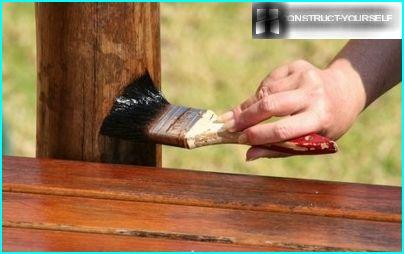
There is a more simple method protective treatment of wood. Before vipiana the lower part of each log is immersed in hot bitumen
Article topic: Review of tools for the protection of wood from moisture, fire, insects and rot
The process of construction of palisade
The traditional way of decorating the fence looks like: pointy bottom end of a log stuck in the ground after the hole pour a little water and re-stick the same post. Screwed the log up until it firmly clicks into place in the soil. To facilitate use of a heavy hammer, but work with them very gently, so as not to damage the integrity of the logs. Some builders in order to protect the pins from chips or cracks, wear on hammers, protective plastic caps.
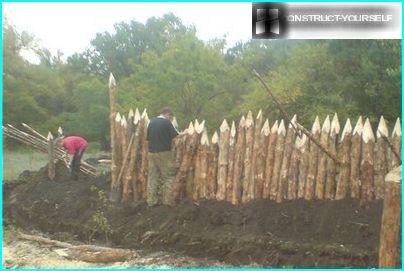
A modern variant of the construction of a palisade arrangement provides trench depth of two feet
The bottom of the trench cover of 20-30 cm sand or gravel «pillow». After her closely to each other and set the stakes, avoiding the formation of gaps between them. The trench is filled with earth and thoroughly compacted. To improve the efficiency of compaction, the soil should be watered with water. To increase the reliability and strength of the enclosing structure is possible, optionally using the double horizontal bars of thick timber. They are placed parallel to each other: the lower one at a height of 20 cm from ground level and the upper 20 cm below the tops of the palisade.
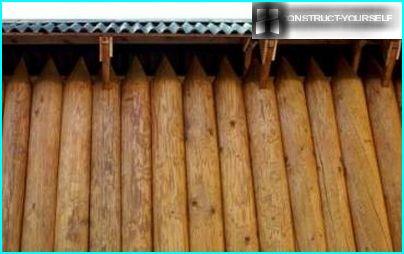
In the final phase of construction of the fence to give the fence a more natural, its surface should be treated with transparent varnish, primer or stain to the wood
Council. Using different concentrations of stain can enhance the decorative effect of the fence, staining it a honey-Golden or chocolate brown shades.
Decorative version of the wicker fence
To style the internal space of the plot, you can use a wicker fence.
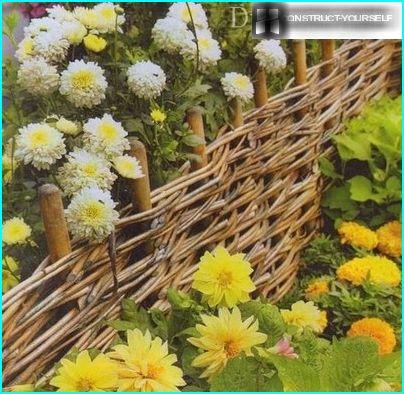
Beautiful woven fence will not only serve the guardrail for walkways and flowerbeds, this element of landscape design will become real «the highlight» decor
Key advantages of the wicker fences include:
- Environmentally friendly. When building a fence we use only natural components that do not bring harm to human health.
- Decorative. Multilevel wicker fences interesting look in any area of the plot: as a miniature railings for mixed borders, as elements of zoning of the territory and even as a full-fledged high fence.
- Ease of erection. The technique of weaving of the fence can learn even the beginner.
To make this fence you can use branches, flexible vines, hazel, willow and even oak or pine.
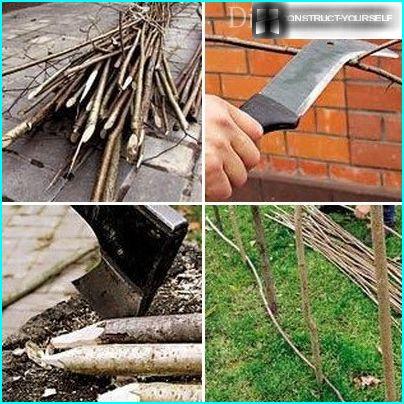
The material for the fence is harvested in the fall. At this time, SAP flow in plants slows down and growth stops. For work best suited to branches with a thickness of 1-3 cm
Deciding to build on the plot wicker fence to mark the territory. On the marked place dug a shallow trench, which is filled with a layer of sand. This sand «pillow» will provide drainage, thereby preventing the decay of the recessed part of the stakes.
You can then drive small stakes, placing them at a distance of two feet from each other. The Foundation is ready, you can begin to weave.
Council. To give the branches more flexible, they can be soaked for a couple of days in warm water. To prolong the stakes and branches, they must be treated with antiseptic.
The weaving starts from the bottom layer. The technology is fairly simple: the bars at a time to start from opposite sides of the stakes and stretch them to full length. As needed short rods are extended, long cut shears.
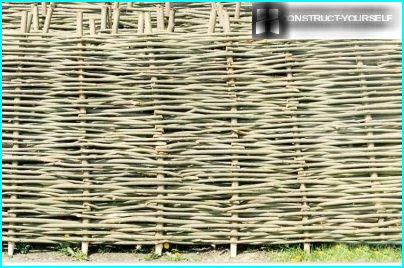
Depending on the density of the stumble branches, you can get the practical deaf or translucent, allowing the sun’s rays the fence. Classic wicker fence regularly serve as decorative fencing more than 5 years
The technique of weaving is clearly described in the video:



